Steve Jobs once said “people don’t know what they want until you show it to them” and he was exactly right. When a new product or piece of content is created and promoted through audio and visual platforms, it often leads to increased curiosity from the consumer. With each additional marketed message, the audience becomes more emotionally attached, and soon that intrigue leads to a sale or an investment of their time. It’s this very formula that fuels the growth of the music, sports, and entertainment industries.
When Jobs introduced the Apple computer, iPod, and iPhone, people lined up to purchase each product because they believed in the possibilities of what those products represented. They had no knowledge of how they’d work because they’d yet to use them, but because they were marketed well and ignited the consumer’s interest, it led to massive sales, and made Apple one of America’s most successful companies.
 It was that same approach that led 30 NFL owners to change direction and throw their support behind Rams owner Stan Kroenke when he was looking to move his team from St. Louis to Los Angeles earlier this year. Kroenke had to overcome competition from the Raiders and Chargers to turn the tide in his favor, and to do so, he let a room full of billionaires see the vision and fall in love with its possibilities.
It was that same approach that led 30 NFL owners to change direction and throw their support behind Rams owner Stan Kroenke when he was looking to move his team from St. Louis to Los Angeles earlier this year. Kroenke had to overcome competition from the Raiders and Chargers to turn the tide in his favor, and to do so, he let a room full of billionaires see the vision and fall in love with its possibilities.
“One of the most important things that nailed it (Tuesday) is that we just kept showing them pictures,” Kroenke said. “People love pictures. And what those pictures showed was the thought and the development and the plan, and the depth of the thought.”
When a great idea is captured visually, it becomes more enticing to the consumer. It percolates in their minds and fuels their curiousity. This is what drives large activity and interest in social and digital media.
Throughout the years, radio has been consistently late to the party when new ideas have been introduced. Whether it was the creation of websites, streaming, mobile listening, or the use of social media marketing, there’s always been a wait and see approach rather than a dive right in mentality. Whether that’s due to tunnel vision, a shortage of resources, or a fear of compromising its own success over the airwaves, the reality is that radio often plays catch up in a world that thrives on innovation and longs for the next big thing.
For this piece, I want to focus on the surge of social and digital media and how radio is operating in each space. It’s clearly where people are and where future business is moving, and although many brands are represented in these circles, they also lack vision and strategy.
Quite honestly, we are not innovating enough on these platforms. Our creativity and repurposing of content leaves a lot to be desired. We’re providing a basic experience and relying on the medium itself to save us, rather than understanding what must be done in the space to enjoy success.
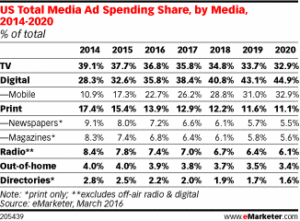 I don’t say this to hurt feelings but rather to enlighten many who may not recognize how many missed opportunities are occurring and how damaging it can be. With digital media projected to rake in 38-45% of all media ad spending between 2017-2020 (the most of any platform) and radio slotted for only 6-7%, you can see why it’s more important than ever to be crisp and creative in these places.
I don’t say this to hurt feelings but rather to enlighten many who may not recognize how many missed opportunities are occurring and how damaging it can be. With digital media projected to rake in 38-45% of all media ad spending between 2017-2020 (the most of any platform) and radio slotted for only 6-7%, you can see why it’s more important than ever to be crisp and creative in these places.
I browsed thirty radio station accounts (coast to coast) on Facebook and Twitter, and only two of them promoted their podcasts on their social media accounts. The writing for promoting those podcasts lacked any call to action for the listener “Podcast Hour 1 of the ____ show”. No mention of the topics discussed or key headlines offered by the host and no teases for what the listener might learn if they listen.
If you’re including a link and expecting someone to leave the social media platform they’re on, then you’ve got to give them a reason to do so. Otherwise you’ll find those posts deliver lackluster results. Without clicks, your sales team is going to struggle to create a powerful narrative for advertisers who are shifting their radio spending into the digital arena.
As part of my research I discovered numerous radio station websites with mistakes on their websites, including their own lineups. News flash, Colin Cowherd is no longer on 10a-1p on ESPN Radio and Dan Le Batard’s show moved from 4pm over seven months ago.
I also learned that there are networks out there without a Facebook page and limited activity on Twitter. If these platforms are where your audience resides each day then how can you afford not to be present?
Some of our best shows are on the air for 20-25 hours per week. There’s a lot of opinion, humor, insight, and breaking news taking place during those hours, yet we lose sight of the fact that the audience isn’t consuming every minute of content that we provide. The material we create lives forever on our websites, but once the show is done, we assume everyone has heard it and consider the job complete once we upload the audio files onto the website.
However, we’re forgetting afterwards to promote our full hours, smaller audio clips, and special guest interviews. We also fail to use graphics to highlight big opinions, stories, and one-liners offered by our talent to redirect the audience back to our websites afterwards. Why? The content is available and the majority of the local population hasn’t heard it, but because the show ended when the host delivered their final word it’s no longer relevant? That’s a giant mistake.
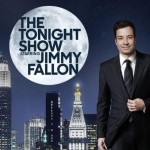 I’ve mentioned this numerous times, but Jimmy Fallon’s show is a hit because it exists well beyond the window of which it airs on television. Each day it’s promoted throughout all social media platforms, and when quality content is available in smaller lengths, people make it a point to check it out. Even if they saw it the night before, if it was great, they’ll watch it again, and share it with their friends.
I’ve mentioned this numerous times, but Jimmy Fallon’s show is a hit because it exists well beyond the window of which it airs on television. Each day it’s promoted throughout all social media platforms, and when quality content is available in smaller lengths, people make it a point to check it out. Even if they saw it the night before, if it was great, they’ll watch it again, and share it with their friends.
For radio, we hear something while we’re in the car or listening on our phone, and have no reason to share it on social media platforms because it’s not available. To showcase it, we have to log on to the station’s website, copy the link, go back to our social media accounts, incorporate the link and write a line or two about it, and then press send, rather than just click the share button because the radio station we listen to made it available.
If by chance it is available, it’s often a full hour of content and that’s less likely to generate a click. Radio rarely offers smaller chunks of audio to its audiences via social media, and when something is provided, it’s usually not followed up the next day or the day after. If you want people to consume your content, put it in the right places, make it quick and easy to consume, and offer it consistently.
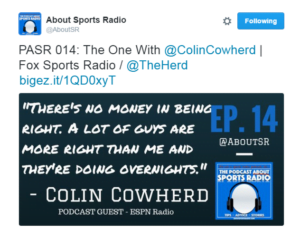 Take a look at the way Zach McCrite promotes a guest’s appearance on the “Podcast About Sports Radio” and think about the way this could be utilized with your station and/or top talk show. Each day hosts on sports radio stations are delivering headline worthy opinions, interesting facts or stories about themselves, and welcoming guests who treat them to new information. With a little time, effort, creativity, and promotion on social platforms, you can engage your audience and draw them back to your content.
Take a look at the way Zach McCrite promotes a guest’s appearance on the “Podcast About Sports Radio” and think about the way this could be utilized with your station and/or top talk show. Each day hosts on sports radio stations are delivering headline worthy opinions, interesting facts or stories about themselves, and welcoming guests who treat them to new information. With a little time, effort, creativity, and promotion on social platforms, you can engage your audience and draw them back to your content.
One other trend I unfortunately noticed during my research was how only a handful promoted their key talk shows prior to going on the air. Those who did, offered the daily guest list.
Nearly half provided minimal interactions during their shows too. If you have thousands of people following your brand on social media, is it not possible that a meter or two might be part of the group? All it takes is letting them know there’s something worthwhile to tune in for, and if they do, it can lead to your show gaining additional ratings credit.
As far as promoting the guest list is concerned, here’s the issue with it. Are you telling your audience that your host(s) doesn’t have something interesting, funny, or powerful for the audience to tune in for? Do you think that the only reason they put the dial on is because of who you booked? The names may look sexy, and certain guests do lead to tune-ins, but so does a powerful opinion, a piece of information the audience may not be aware of, an opportunity to win a big prize, or a chance to call in and interact with the show.
Rather than tossing out the usual “Today’s show includes Michael Irvin at 7:30am, Karl Ravech at 8:15am and Jerry Crasnick at 9:30am”, how about adding a popular question, topic, or fact with the guest to make it more intriguing? For example, “How would Adam LaRoche’s situation be handled in an NFL locker room? Michael Irvin’s answer at 7:30am will surprise you.”
Aside from promoting guests, there are many other layers inside of a talk show that are important to the audience, and when you look at a 9-12 segment show, if a guest occupies 3 of those segments, that means 6-9 others don’t include a guest. By not promoting other topics, stories, and opportunities to interact, you’re telling the audience to worry about 1/3 of your show, not the rest of it.
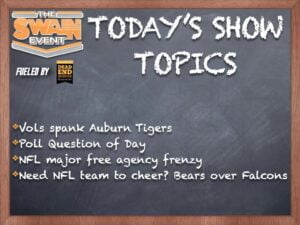 I came across this example from “The Swain Event” and while I believe it needs more detail to draw people in, I was impressed with the effort prior to the show to try and give the audience an idea of what was coming up. They didn’t type 140 characters and rely on text to engage people, they instead used a graphic to make it more visually appealing. With some improved detail on the chalkboard, this can lead to listeners looking forward to learning what’s coming up each day.
I came across this example from “The Swain Event” and while I believe it needs more detail to draw people in, I was impressed with the effort prior to the show to try and give the audience an idea of what was coming up. They didn’t type 140 characters and rely on text to engage people, they instead used a graphic to make it more visually appealing. With some improved detail on the chalkboard, this can lead to listeners looking forward to learning what’s coming up each day.
Next, if you’ve not been paying attention, Facebook has invaded the video space, and they’re determined to make sure that you have zero reason to leave their platform to use Periscope or any other video application. With their entry into the video world comes big opportunity for radio stations and talk show hosts.
We know the audience spends a large portion of their time each day on Facebook, and the interest in being a fly on the wall inside the studio has always been high. It’s why radio show simulcasts on television have been such a hit.
 If you don’t have a television deal, this can be a great way to bring your audience on the inside and further promote your station and content. Depending on your radio station’s following on Facebook, you could end up with more people watching your video stream than they would a simulcast of your show on local television.
If you don’t have a television deal, this can be a great way to bring your audience on the inside and further promote your station and content. Depending on your radio station’s following on Facebook, you could end up with more people watching your video stream than they would a simulcast of your show on local television.
Something to keep in mind for the sales end of your operation, this could pay dividends for your clients too. Imagine if the host’s shirt was provided by a client. Or if they had a soft drink in front of them. Or a visual display behind them. The opportunities are endless.
Yes you can expect that Facebook is going to want their fair share of what you generate, but if advertisers are demanding your brand deliver bigger in social and digital spaces, this is an easy way to tap into it. Take a look at this example of the Haberman and Middlekauff show in San Francisco on 95.7 The Game who have already started video streaming daily.
You can already see how many views are coming in and as Facebook grows even bigger in the video world, you can expect the data will become even stronger for clients to take advantage of. One suggestion if you’re using this service, pay attention to the comments delivered by your listeners. If they’re taking the time to watch you, and trying to contribute to your program, they’re just as valuable as the person who’s taking the time to call your studio line while at work or in the car.
Although Facebook is powerful and expected to become an even bigger player in the video world, there are other video options available. Periscope for instance has been a huge attraction and plays perfectly with Twitter. With sports becoming a phenomenon in the Twittersphere, having your talent available in this location makes a ton of sense. It’s even better if you can find ways to incorporate your clients into it.
 I was doing some digging and I stumbled across this example of what 106.7 The Fan in Washington DC is doing. Sports Anchor Pete Medhurst not only promotes and delivers his updates on Periscope and Twitter, but he also includes promotion for the sponsor and includes their twitter ID in his posts.
I was doing some digging and I stumbled across this example of what 106.7 The Fan in Washington DC is doing. Sports Anchor Pete Medhurst not only promotes and delivers his updates on Periscope and Twitter, but he also includes promotion for the sponsor and includes their twitter ID in his posts.
This shows the sponsor that they’re receiving their promotion, it makes them look good to those who follow the station and personality, and it’s non-intrusive which means the audience is less likely to be turned off by it. That’s very smart and something the sales team in DC can use with their clients to remind them that they’re incorporated into the radio station’s multi-media strategy.
Although some of these examples above show how we’re making strides to improve, we’ve still got to do a better job in how we highlight the content to get the audience interested in clicking our links. Too often station’s post links and headlines that leave little to be desired. You’ll see something like this: “Team X loses third straight”.
Ask yourself this, why would I click the link to that story on a radio station’s website, when ESPN, Yahoo, Sports Illustrated, Fox, Bleacher Report, and every other major national sports brand has the same result and likely more detail? If there’s no suspense or personalization, good luck driving large amounts of clicks.
If you think about the headline on the front page of a newspaper, it’s sole purpose is to get you to click the link and read the story. If you’re an old school individual who still likes to have the paper in their hand, they’re hoping to catch your eye and get you to buy the paper.
It’s that same mentality that’s needed when promoting your content on Facebook, Twitter, Instagram, or your own website. If you peak the listener’s curiosity, you stand a chance of them reading or listening to the content. If your headline lacks imagination and any sort of hook, the chances of them spending time consuming it becomes less.
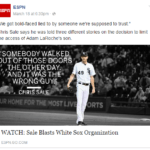 Take a look at the way ESPN promoted Chris Sale’s reaction to the Adam LaRoche story. The text in the photo combined with the written message in the body of the post, displays great drama and makes you want to see what Sale said. ESPN even puts the word “WATCH” in capital letters to make sure you know that video exists and should be seen.
Take a look at the way ESPN promoted Chris Sale’s reaction to the Adam LaRoche story. The text in the photo combined with the written message in the body of the post, displays great drama and makes you want to see what Sale said. ESPN even puts the word “WATCH” in capital letters to make sure you know that video exists and should be seen.
This story was popular and relatable to most people, and the way ESPN highlighted it increased their chances of gaining additional clicks.
The reason we spend the time creating content is to get an audience to consume it. When listeners become attached to our programming, that makes them attractive to advertisers, which allows our companies to capitalize on their listening and ultimately create a business. The focus for many in programming may not be on the bottom line but without positive results, there is no programming to offer.
If there’s two key things to takeaway from this column, it should be that content lives beyond your shift, and it must be distributed and promoted in a much more creative way across multiple locations consistently. The growth in digital is massive and it’s where the world’s listening and spending are headed. If radio isn’t dominant in this space, it’s going to have limited appeal and miss out on larger economic opportunities.
To those who are hosting or producing a show, think about the content you create and the multiple ways it can be promoted. That means using social media to promote your material before the show, during the show, and after the show. That includes providing long-form audio, shorter clips of memorable content, interviews, and anything else that’s clickworthy. Help yourself by taking notes during the show so the best stuff you create doesn’t get lost in the shuffle.
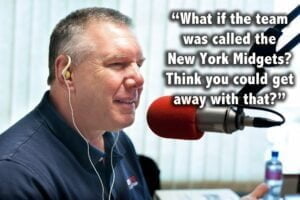 Anytime you can provide an image to help your material cut through the clutter, it’s highly recommended. If providing a plain text post leads to a 3 out of 10 response, and a visual post doubles your chances, isn’t it worth it to put the extra time in to create something that intrigues your audience? Similar to the Podcast About Sports Radio example, here’s something 101 ESPN in St. Louis did to highlight the opinions of their hosts.
Anytime you can provide an image to help your material cut through the clutter, it’s highly recommended. If providing a plain text post leads to a 3 out of 10 response, and a visual post doubles your chances, isn’t it worth it to put the extra time in to create something that intrigues your audience? Similar to the Podcast About Sports Radio example, here’s something 101 ESPN in St. Louis did to highlight the opinions of their hosts.
When you see this type of graphic, it peaks your curiosity. The text involves drama and leaves you wanting to learn more about the subject. These type of moments though get lost because we don’t think enough about how to use shorter content as a tool to increase consumption. If we’re listening to our talent, and maximizing the massive amounts of great content they produce during a show, we’ll thrive in the digital space.
Remember, there are few platforms generating 16-24 hours of live sports content per day. Every minute becomes an opportunity. The issue for our industry in social and digital arenas has never been a lack of quality material. It’s our own lack of awareness and reliance on doing what’s acceptable instead of what’s remarkable.
If we utilize our creativity, deliver consistently, and provide a little extra TLC to the various ways we can highlight our content on these platforms, we’ll satisfy the needs of the audience and make ourselves and our business viable and necessary. Our future earning potential depends on the way we adapt to this challenge. Let’s hope for all of our sakes that radio doesn’t repeat its previous mistakes.
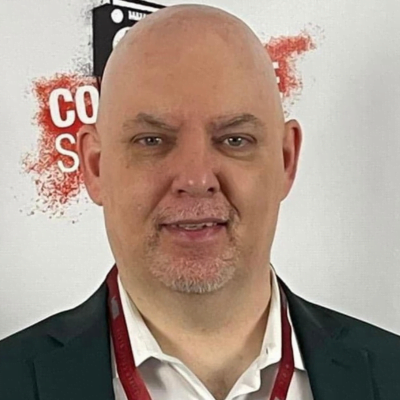
Jason Barrett is the Founder and CEO of Barrett Media. The company launched in September 2015 and has provided consulting services to America’s top audio and video brands, while simultaneously covering the media industry at BarrettMedia.com, becoming a daily destination for media professionals. Prior to Barrett Media, Jason built and programmed 95.7 The Game in San Francisco, and 101 ESPN in St. Louis. He was also the first sports programmer for SportsTalk 950 in Philadelphia, which later became 97.5 The Fanatic. Barrett also led 590 The Fan KFNS in St. Louis, and ESPN 1340/1390 in Poughkeepsie, NY, and worked on-air and behind the scenes at 101.5 WPDH, WTBQ 1110AM, and WPYX 106.5. He also spent two years at ESPN Radio in Bristol, CT producing ‘The Dan Patrick Show’ and ‘GameNight’. JB can be reached on Twitter @SportsRadioPD or by email at Jason@BarrettMedia.com.




